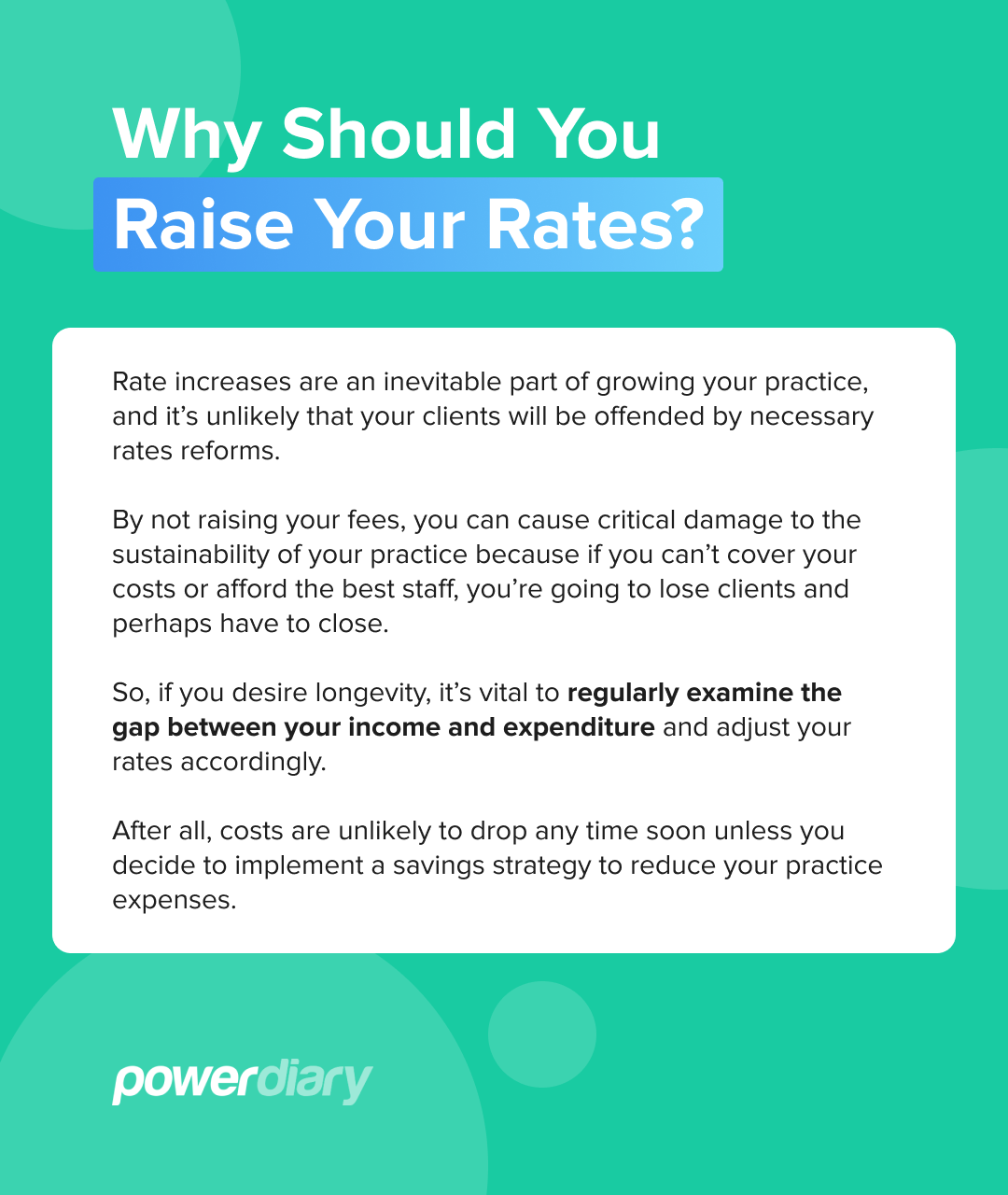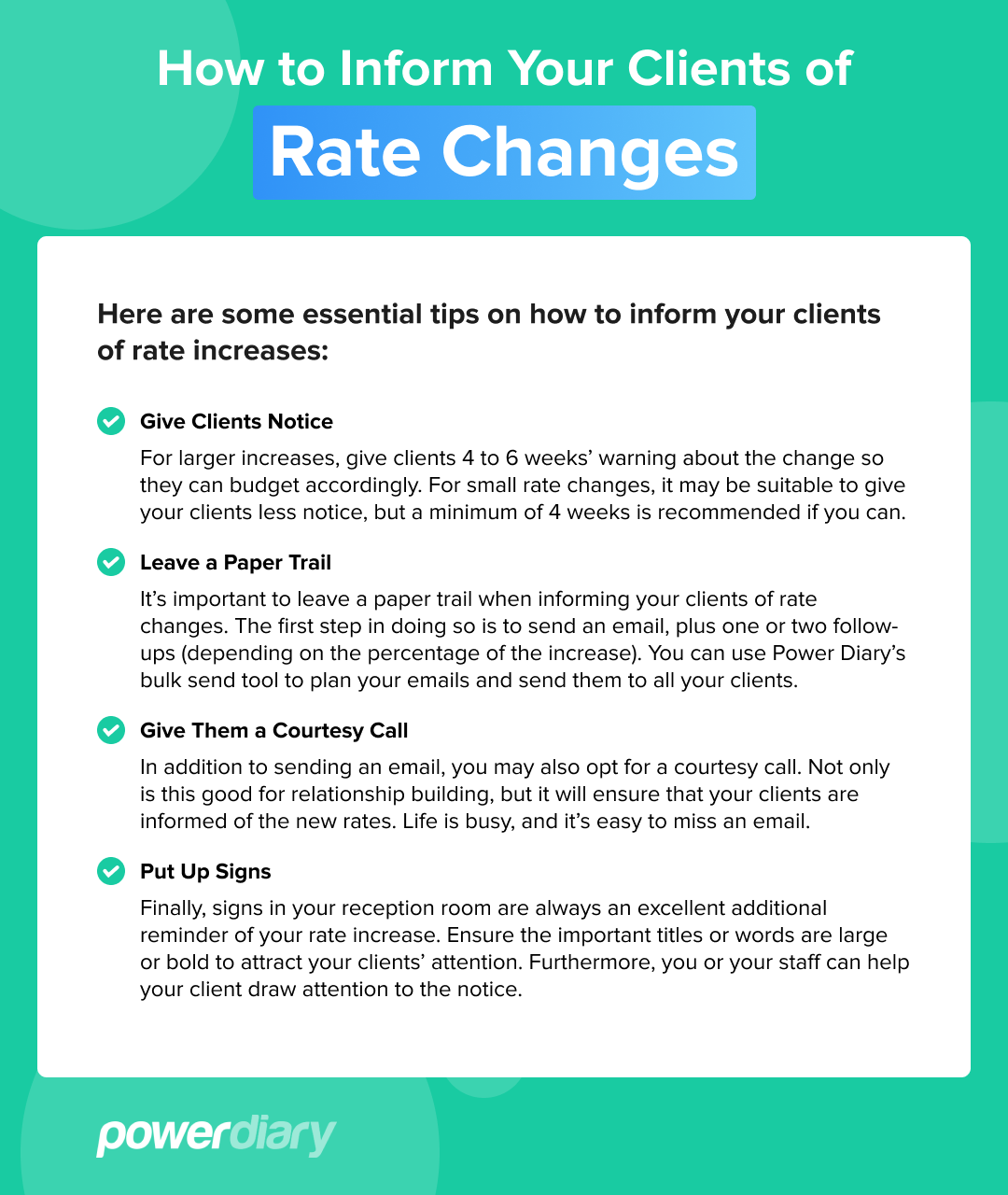One of the biggest mistakes private practices can make is not increasing rates when necessary. Often, this happens because practitioners feel guilty or disloyal to their clients by raising rates.
Don’t fall into that trap!
With the global economic climate undergoing major fluctuations, costs are increasing for everyone and your practice is no different. There’s nothing wrong with raising your rates to meet the needs of your practice and, if you don’t, there’s every chance that your business will suffer in the long run.
But, even if you’re happy to agree that you need to raise your rates, there are still two important questions that you need to settle when thinking about how to increase rates in private practice:
- How do you set your increase?
- How do you implement it successfully?
Let’s get into it…
Why Raise Your Rates?
Rate increases are an inevitable part of growing your practice, and it’s unlikely that your clients will be offended by necessary rates reforms. By not raising your fees, you can cause critical damage to the sustainability of your practice because if you can’t cover your costs or afford the best staff, you’re going to lose clients and perhaps have to close. So, if you desire longevity, it’s vital to regularly examine the gap between your income and expenditure and adjust your rates accordingly.
After all, costs are unlikely to drop any time soon unless you decide to implement a savings strategy to reduce your practice expenses.
Your highest rising costs may include:
Inflation Rates
The simplest and most important answer to ‘why raise your rates’ is inflation. The global inflation rate1 sat at a staggering 4.35% in 2021, which is an annual reality that business owners face. In other words, your business expenses will rise significantly, and as such, your profit will subsequently shrink if you don’t do anything about it.
Rental Increases
If you’re renting your business premises, rental agreements can usually increase by a set percentage annually, depending on where you live and your agreements with your landlord. Once again, if you don’t increase your prices, your profit margins will decrease, causing a detrimental block to the growth of the private practice.
Salary Increases
If you run a private practice, you may employ a receptionist or additional practitioners. As a good-standing employer, annual salary reviews are essential, with a minimum in line with national inflation.
Yet again, your expenditure has gone up, and as such, your income needs to match.
Every Year of Experience is More Experience
Sometimes, price increases are based purely on business development. Every year in private practice is an additional year of growth for you as a professional. Anyone with a career will know that every year spent on a craft is another year towards becoming a master.
As your professional skills grow, you and your practice should be duly compensated. And, if you want to take it one step further, there will always be a ‘most expensive practice’, and if your business is running smoothly, your décor and corporate identity are on point, your marketing is great, and you are well-respected in the industry, that could be you.
That being said, gradual increases are usually important, as opposed to making a large increase at once. In addition, be transparent about your new rates, and follow essential protocols, as we will unpack below.
The Consequences of Not Evaluating or Raising Your Rates
As we’ve determined, increased costs throughout the year mean that it makes logical sense to raise your rates. This is to make your business model one that’s sustainable.
If you don’t, you could end up losing a significant amount of income. Plus, increased inflation paired with a decrease in income could result in continued longer-term financial losses.
As such, we encourage you to add bi-annual fee reviews to your yearly operational plan.
Determining the Appropriate Rate Increase
Now you know that reviewing your rates is a must, the next step is to determine your new rates. There are a few steps to aid you in finding the right answer.
Start by answering these questions:
- What are competitors charging? Check out your competitors’ rates and find your direct competitors to get a ballpark figure. Remember to compare apples with apples. A recent graduate won’t be as expensive as the most experienced in the industry.
- What value does your practice offer? There’s no reason to suffer under the burden of large expenses if you’re the least expensive practitioner in your area. Find a balance between serving your clients, your own interests, and the interest of your business.
- What are your expenses? Take a detailed look at your income vs expenditure, and ensure that your practice has growth and sustainability.
- What are your goals? If your practice is running at capacity, maybe even with a waiting list, it’s more likely you can afford to raise your rates. But, if your practice still has availability, your increases may need to be smaller as you balance filling your calendar with higher rates.
How to Inform Your Clients of Rate Changes
Here are some essential tips on how to inform your clients of rate increases:
- For larger increases, give clients 4 to 6 weeks’ warning about the change so they can budget accordingly. For small rate changes, it may be suitable to give your clients less notice, but a minimum of 4 weeks is recommended if you can.
- It’s important to leave a paper trail when informing your clients of rate changes. The first step in doing so is to send an email, plus one or two follow-ups (depending on the percentage of the increase). You can use Power Diary’s bulk send tool to plan your emails and send them to all your clients.
- In addition to sending an email, you may also opt for a courtesy call. Not only is this good for relationship building, but it will ensure that your clients are informed of the new rates. Life is busy, and it’s easy to miss an email.
- Finally, signs in your reception room are always an excellent additional reminder of your rate increase. Ensure the important titles or words are large or bold to attract your clients’ attention. Furthermore, you or your staff can help your client draw attention to the notice.
Legal Considerations of Rate Changes
Strictly speaking, there are no rules against increasing your rates. Instead, the above indicates what’s ethical or common practice.
You may also be wondering if you can change rates for some clients and not others. The answer is yes and no. While it’s appropriate to stabilise your rates, offer discounts or do pro-bono work for clients with genuine financial concerns, you can’t ethically raise your rates for some and not others. However, it’s perfectly appropriate to keep existing clients on old rates and offer an increased rate to new ones.
Example Rate Change Templates
Example 1
Subject Line: Notification of Rate Increase Effective 1 January
Dear {ClientFirstName},
Our clients are our top priority and, as such, we strive to offer the best levels of care while keeping our rates as stable as possible (in fact, we haven’t increased them in over X years).
Inflation and rising costs in healthcare mean that we have to raise our rates to keep pace. We’ve kept the increase as low as we can, in most cases rates have only been adjusted for inflation.
Please find the details of our rate increase attached, and our team is available to answer any questions.
We’d like to take this opportunity to thank you for your loyalty and understanding, and we look forward to seeing you in the practice soon.
Yours in health,
{BusinessName}
Example 2
Subject Line: RATE INCREASE NOTIFICATION
Dear {ClientFirstName},
Kindly be informed that as of [DATE], our rates will increase to [AMOUNT] for a 1-hour session. This new rate reflects our increased costs and is in line with market rates according to our experience and credentials. We can assure you that the rate increase is a part of our mission to maintain our practice’s quality of care.
While the new rates will be effective immediately for new clients, we will be offering a 90-day grace period to existing clients to give you time to plan accordingly.
Kindly be in touch if you have any questions or concerns, and thank you for your loyalty to our practice.
Yours sincerely,
{BusinessName}
If you’re thinking about how to increase your rates in private practice, keep in mind that maintaining a solid financial footing is an essential part of growing your practice. But you need to communicate any changes clearly and maintain transparency at all times, which is where Power Diary features can help you do so appropriately. As long as you’re clear with your clients and communicate effectively, it’s unlikely that your loyal clients will leave.
One final thought: if you’re still unsure about increasing your rates, perhaps you should meet with a financial adviser to do a risk analysis of your business because you deserve to see the results of your hard work.







